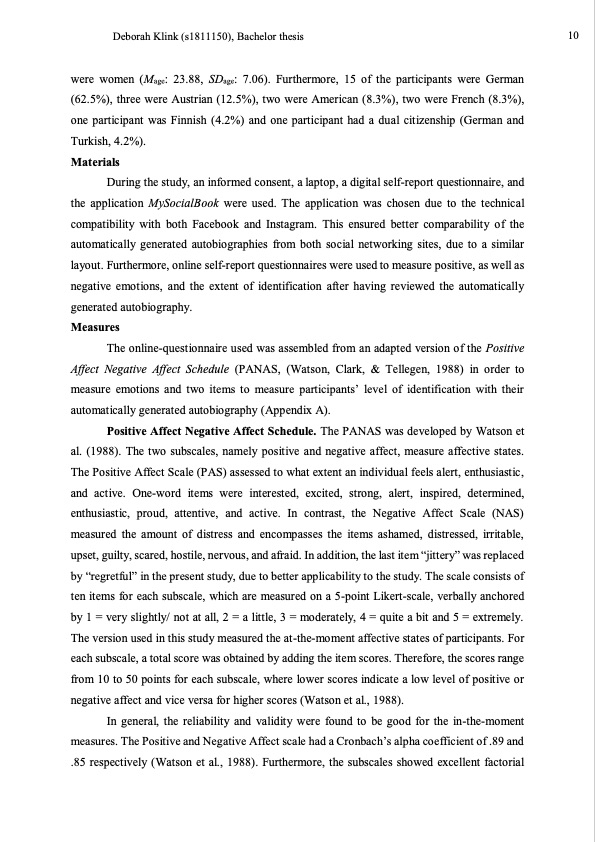
PDF Publication Title:
Text from PDF Page: 011
Deborah Klink (s1811150), Bachelor thesis 10 were women (Mage: 23.88, SDage: 7.06). Furthermore, 15 of the participants were German (62.5%), three were Austrian (12.5%), two were American (8.3%), two were French (8.3%), one participant was Finnish (4.2%) and one participant had a dual citizenship (German and Turkish, 4.2%). Materials During the study, an informed consent, a laptop, a digital self-report questionnaire, and the application MySocialBook were used. The application was chosen due to the technical compatibility with both Facebook and Instagram. This ensured better comparability of the automatically generated autobiographies from both social networking sites, due to a similar layout. Furthermore, online self-report questionnaires were used to measure positive, as well as negative emotions, and the extent of identification after having reviewed the automatically generated autobiography. Measures The online-questionnaire used was assembled from an adapted version of the Positive Affect Negative Affect Schedule (PANAS, (Watson, Clark, & Tellegen, 1988) in order to measure emotions and two items to measure participants’ level of identification with their automatically generated autobiography (Appendix A). Positive Affect Negative Affect Schedule. The PANAS was developed by Watson et al. (1988). The two subscales, namely positive and negative affect, measure affective states. The Positive Affect Scale (PAS) assessed to what extent an individual feels alert, enthusiastic, and active. One-word items were interested, excited, strong, alert, inspired, determined, enthusiastic, proud, attentive, and active. In contrast, the Negative Affect Scale (NAS) measured the amount of distress and encompasses the items ashamed, distressed, irritable, upset, guilty, scared, hostile, nervous, and afraid. In addition, the last item “jittery” was replaced by “regretful” in the present study, due to better applicability to the study. The scale consists of ten items for each subscale, which are measured on a 5-point Likert-scale, verbally anchored by 1 = very slightly/ not at all, 2 = a little, 3 = moderately, 4 = quite a bit and 5 = extremely. The version used in this study measured the at-the-moment affective states of participants. For each subscale, a total score was obtained by adding the item scores. Therefore, the scores range from 10 to 50 points for each subscale, where lower scores indicate a low level of positive or negative affect and vice versa for higher scores (Watson et al., 1988). In general, the reliability and validity were found to be good for the in-the-moment measures. The Positive and Negative Affect scale had a Cronbach’s alpha coefficient of .89 and .85 respectively (Watson et al., 1988). Furthermore, the subscales showed excellent factorialPDF Image | Facebook and Instagram emotions identification automatically generated autobiography

PDF Search Title:
Facebook and Instagram emotions identification automatically generated autobiographyOriginal File Name Searched:
thesis-instagram-comparison-instagram-vs-facebook.pdfDIY PDF Search: Google It | Yahoo | Bing
Cruise Ship Reviews | Luxury Resort | Jet | Yacht | and Travel Tech More Info
Cruising Review Topics and Articles More Info
Software based on Filemaker for the travel industry More Info
The Burgenstock Resort: Reviews on CruisingReview website... More Info
Resort Reviews: World Class resorts... More Info
The Riffelalp Resort: Reviews on CruisingReview website... More Info
| CONTACT TEL: 608-238-6001 Email: greg@cruisingreview.com | RSS | AMP |